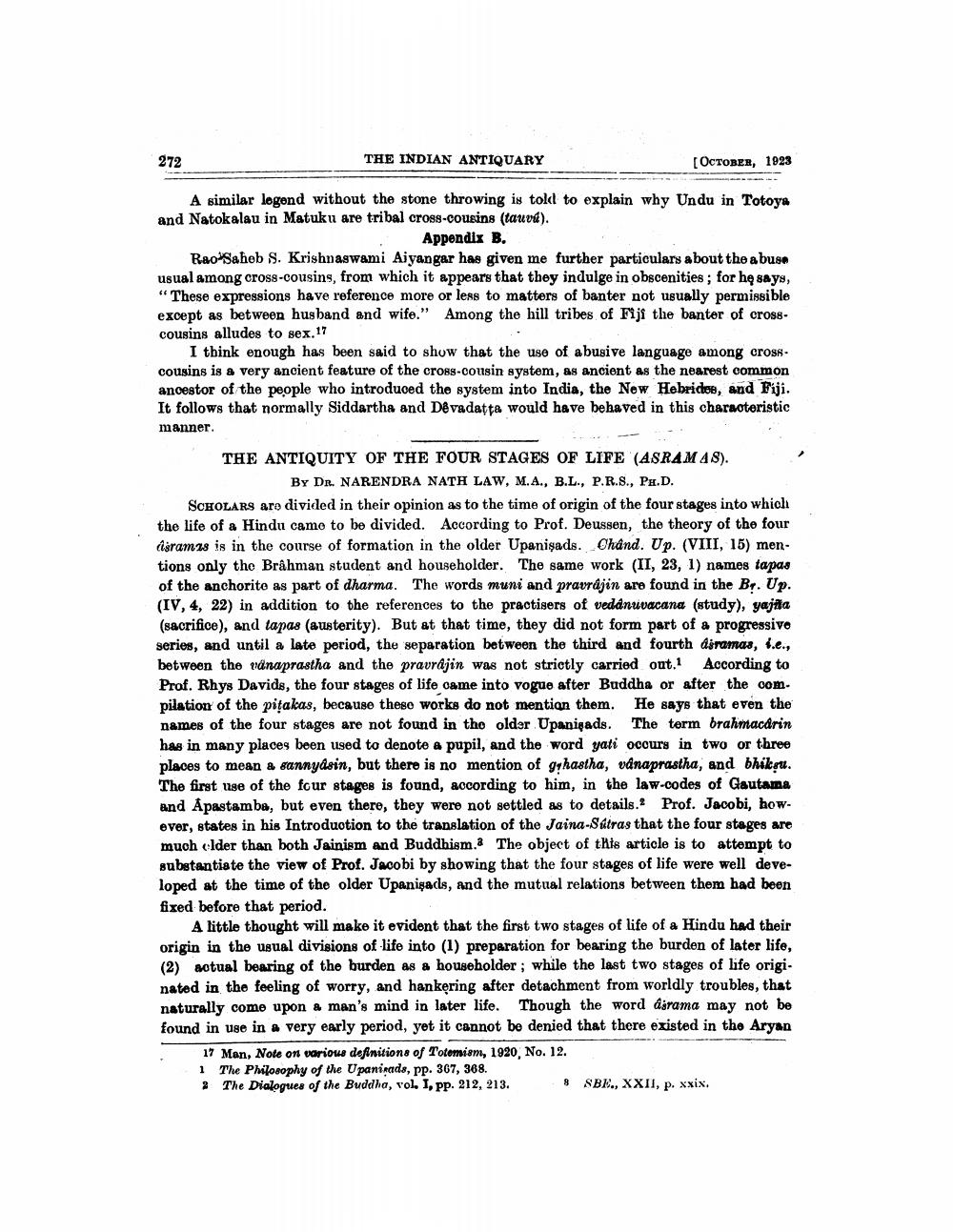________________
272
THE INDIAN ANTIQUARY
[OCTOBER, 1923
A similar logond without the stone throwing is told to explain why Undu in Totoya and Natok alau in Matuku are tribal cross-cousins (tauvd).
Appendix B. Rao Saheb S. Krishnaswami Aiyangar has given me further particulars about the abuse usual among cross-cousins, from which it appears that they indulge in obscenities; for he says, "These expressions have reference more or less to matters of banter not usually permissible except as between husband and wife." Among the hill tribes of Fuji the banter of crosscousins alludes to sex.17
I think enough has been said to show that the use of abusive language among crosscousins is a very ancient feature of the cross-cousin system, as ancient as the nearest common ancestor of the people who introduoed the system into India, the New Hebridoe, and Fiji. It follows that normally Siddartha and Devadatta would have behaved in this charaoteristic manner.
THE ANTIQUITY OF THE FOUR STAGES OF LIFE (ASRAMAS).
By Dr. NARENDRA NATH LAW, M.A., B.L., P.R.S., Ph.D. SCHOLARS are divided in their opinion as to the time of origin of the four stages into which the life of a Hindu came to be divided. According to Prof. Deussen, the theory of the four asramus is in the course of formation in the older Upanisade. Ohand. Up. (VIII, 15) mentions only tho Brahman student and householder. The same work (II, 23, 1) names tapas of the anchorite as part of dharma. The words muni and pravrájin are found in the Br. Up. (IV, 4, 22) in addition to the references to the practisers of vedanuvacana (study), yajita (sacrifice), and tapas (austerity). But at that time, they did not form part of a progressivo series, and until a late period, the separation between the third and fourth dsramas, 6.e., between the ränaprastha and the pravrajin was not strictly carried out. According to Prof. Rhys Davids, the four stages of life oame into vogue after Buddha or after the com pilation of the pitakas, because these works do not mention them. He says that even the names of the four stages are not found in the older Upanipads. The term brahmacarin has in many places been used to denote a pupil, and the word yati occurs in two or three places to mean a sannyåsin, but there is no mention of gyhastha, vanaprastha, and bhiksu. The first unge of the four stages is found, according to him, in the law-codes of Gautama and Apastamba, but even there, they were not settled as to details. Prof. Jacobi, however, states in his Introduotion to the translation of the Jaina-Stras that the four stages are much older than both Jainism and Buddhism. The object of this article is to attempt to substantiate the view of Prof. Jacobi by showing that the four stages of life were well developed at the time of the older Upanişads, and the mutual relations between them had been fixed before that period.
A little thought will make it evident that the first two stages of life of a Hindu had their origin in the usual divisions of life into (1) preparation for bearing the burden of later life. (2) actual bearing of the burden as a householder; while the last two stages of life originated in the feeling of worry, and hankering after detachment from worldly troubles, that naturally come upon a man's mind in later life. Though the word asrama may not be found in use in a very early period, yet it cannot be denied that there existed in the Aryan
17 Man, Note on various definitions of Totomiem, 1920, No. 12. 1 The Philosophy of the Upanigads, pp. 367, 368. 2 The Dialogues of the Buddha, vol. I, pp. 212, 213. 8 SBE., XXII, p. xxix.




